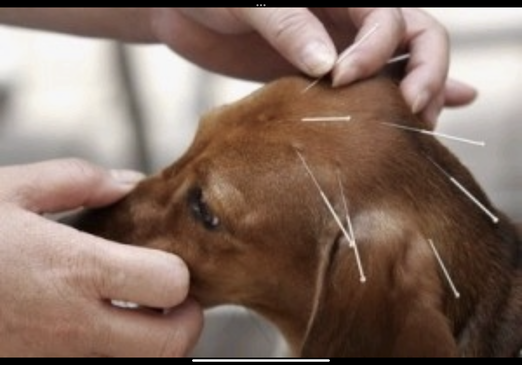
Holiday Joy for Pets: The ‘Yes, They Can Have That’ Edition
Every year around this time pet owners are warned about toxic foods and holiday hazards. And while it’s important to
Weeknights 7PM - Midnight
Weekends 8AM - Midnight

A story of how one veterinarian found acupuncture as an alternative way to manage pain in pets.
By Dr. Christie Schroth
After about ten years of practice as a small animal general practice veterinarian I started noticing there were some needs unanswered by traditional Western medicine. Dogs were starting to live well into their teenage years and many were afflicted by painful degenerative joint disease, intervertebral disc disease, and musculoskeletal pain. Many of these dogs were on a multi-modal pain management regimen such as joint supplements and combinations of medications; non-steroidal anti-inflammatories, opioids, gabapentin, and the list goes on. These dogs were still in serious pain. I wanted to find a new way to help them. I decided that by becoming a Certified Veterinary Acupuncturist I would be more suited to improve the lives of pets in pain.
Acupuncture is a form of traditional Chinese medicine. It is the practice of inserting very thin needles into various points around the body. Most commonly it is used to alleviate pain but can be also be utilized for general health and wellness. Acupuncture points are located around the body at locations where there are a lot of nerve endings and small blood vessels. Placing the needle in the points helps to stimulate blood flow, nerve transmission, and the release of naturally occurring pain relievers, endorphins. The first veterinary acupuncture textbook was written approximately 1300 years ago!
To become a Certified Veterinary Acupuncturist (CVA), one has to start by being a licensed veterinarian(check!!). Then, I took a very challenging and intensive course at the Chi Institute (now Chi University) in Reddick, Florida. The first part of the course consisted of two months of on-line lectures to learn about traditional Chinese medicine theory and the lines throughout the body upon which the acupuncture points are located. The second part of the course included visiting the Chi Institute three times to have hands-on learning with dogs and cats. I then had to pass both a written exam and a “point”test to show that I could correctly place needles in my patients. After a six-month process, I completed a thirty hour internship with a CVA. My last step before certification was to write a case report on a pet that I treated for three months or more with acupuncture.
I chose Winnie, a 13-year-old Beagle owned by a coworker, for my case report. Winnie had a history of intense back pain and was on all of the medications and supplements I mentioned earlier. Every Thursday afternoon for five months, Winnie had her session. Only thirty percent of dogs will have a noticeable response to only one treatment. This is because the effects of acupuncture are cumulative. Winnie showed a great positive response after only one treatment! Sixty percent of dogs will respond to two treatments and ninety percent of dogs will respond to treatment number three. As time went on it was obvious to me that Winnie benefited greatly from acupuncture. We continued to have weekly sessions well past the length of time required for my case study. Winnie went on to live another two years. Her quality of life was fantastic. It became obvious to us that acupuncture would have great benefits in our practice.
It has been one of the most fulfilling experiences of my career to be able to offer this integrative medicine practice into our clinic. It is so amazing to have more options to treat chronic pain than just prescribing another medication or supplement. It’s taught me, and also our clients, to think outside of our box of traditional Western medicine and has opened a whole new world of possibilities.

Every year around this time pet owners are warned about toxic foods and holiday hazards. And while it’s important to

Life on the Inside: How to Keep Indoor Cats Happy (and Out of Trouble) There’s something fascinating about how differently

Do dogs really experience the same “vacation exhaustion” that we do, even when they’re having fun? Turns out, science says yes—kind of.
Pets After Dark is a subscription-based service that provides expert, local after-hours veterinary care.